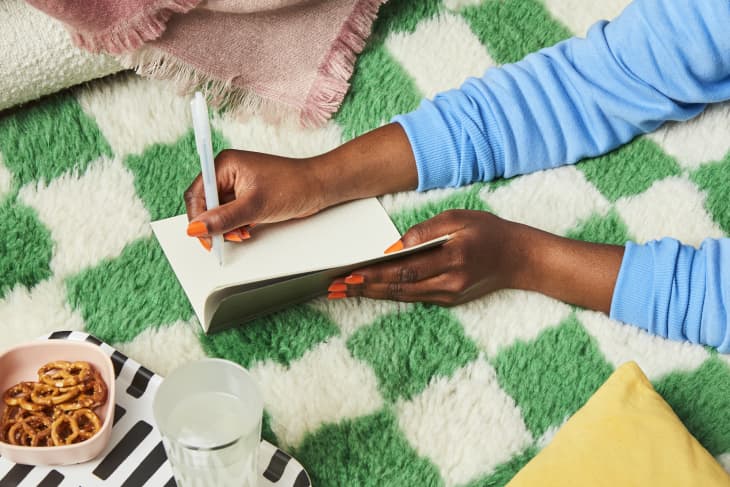Here’s Why a “Junk Journal” Is So Freeing, According to 3 People Who Swear by It

I have been known to give away a sentimental item or two (hundred). When my family inevitably guffaws at my heartlessness, I usually say I care about stories, not stuff. I’ve never understood the need to hold onto things; in my mind, it’s all just clutter.
But recently a sentimentalist friend of mine stopped me in my tracks with this statement: “If I get rid of this memory trigger,” she said, “I will forget how that experience made me feel.” At that moment, I finally understood why my family was aghast when I threw out my homecoming mum; to them, it was a tiny memory death.
I don’t have the room to store trunks full of memories, but I would like to make space in my life for a little more meaningful clutter. Enter: junk journaling.
What Is a Junk Journal?
According to junk journal TikTok, junk journaling is scrapbooking’s less intense cousin. In a junk journal, objects normally destined for the trash are collected and pasted inside a notebook. There’s no need to buy expensive acid-free paper, embellishments, or fancy books. Rather than discarding meaningful objects from your day-to-day life, you give them a home in the journal.
A handwritten grocery list, a concert wristband, or a beautiful leaf are all appropriate junk journal contributions. It’s a creative exercise in being present and memorializing the ordinary.
Why You Might Start a Junk Journal
TikToker Cheyenne Livelsberger (@livebrave2 on TikTok) has been junk journaling since she was 11 (she’s now 22) and revisits old journals at least once a month. “I love being able to look back and feel in touch with that past version of myself,” she says. Her unbridled enthusiasm for the practice is contagious and a good reminder that “because it’s fun” is reason enough to begin.
Francesca Radice (@junkjournaljoy on TikTok), on the other hand, rarely revisits old journals. “I enjoy the moment I create my book more than looking at it once it’s finished … I’m more oriented towards enjoying the process,” she says. Radice’s first junk journal experience was turning her late mother’s diary into a work of art. “The process of creating that book helped me mourn,” Radice says.
“I think the junk journal has helped [me] with acceptance,” says Margaret Duncan (@bad_art_everyday on TikTok), who has been junk journaling for approximately six years. She calls junk journals “an artistic way to practice and remember gratitude.” Mementos from good and bad days make their way to the junk journal, without judgment. “If I have an awful first date, or if something hard happens [at] work,” there’s no need to spin those experiences into happy ones, says Duncan.
How to Make a Junk Journal
In Duncan’s TikTok on the topic viewed more than 25,000 times, she illustrates the process in a series of cozy images. Some of her junk journal items include a flower from a date, an old bookmark, and some colorful tissue paper. As she puts it in the video, you can use “literally anything that can be made flat.”
Supplies You’ll Need to Start a Junk Journal
- A journal or notebook
- Some type of adhesive: glue stick, double-sided tape, or fabric glue
- Found treasures
- A shoebox or similar-sized container
Step-by-Step Instructions to Make a Junk Journal
- Gather ephemera: Throughout the week, Duncan collects scraps for junk journaling. In her TikTok, she includes a wine bottle label from a girls’ night and a sticker that reads, “I love you. I’m glad I exist,” among other bits and bobs. Keeping an eye out for treasures “makes every day feel like ‘I Spy,’” Duncan says.
- Press three-dimensional objects. Try to keep contributions relatively flat so the journal can close. To press flowers, Duncan sprays them with hairspray and places them in a book for a couple of days. If you’re worried about damaging books, you could press flowers with an iron instead.
- Store scraps in the box or tin until you’re ready to journal. This holder can be as large or small as your journaling ambitions.
- Transfer the contents of the box to the journal: On Sundays, Duncan glues items into the journal, transforming junk into art. (You can pick a day that works best for you.) Glue sticks and double-sided tape work well for keeping items in place. Radice recommends Fabri-Tac for heavier scraps, because, as she explains on TikTok, it “dries clear, is strong… and is good for both paper and fabrics.”
Junk Ideas
When it comes to your personal junk journal, there are no rules, but here are a few contribution ideas from Duncan, Livelsberger, and Radice to get you started.
- Bookmarks
- Dried leaves or flowers
- Concert wristbands
- Parking stubs
- Tickets
- Wrapping paper
- Ribbon
- Lace
- Tissue paper
- Programs
- Postcards
- Comics
- Magazine clippings
- Receipts
- Candy wrappers
- Greeting cards
- Stickers
- Stamps
- Fabric
- Lists
- Flyers
- Business cards
- Notes from friends
- Paper menus
- Doilies
Tips for Next-Level Junk Journaling
Looking to up your junk journal game? Try these practices.
- Create eco-friendly journals made from recycled packages.
- Incorporate traditional journaling or sketches in the margins.
- Add photographs or mobile tickets with this HP Sprocket Portable Instant Color Photo Printer Livelsberger swears by.
If any of this feels too *extra*, stick to the basics and enjoy the experience.
Make It Yours
Whether your motivation is to be fully present in your daily life, create art on a regular basis, or recap your weekends, Duncan encourages beginners to start small with a short journal and avoid perfectionism. “I think it always ends up looking interesting, which is almost always better than perfect,” she says.